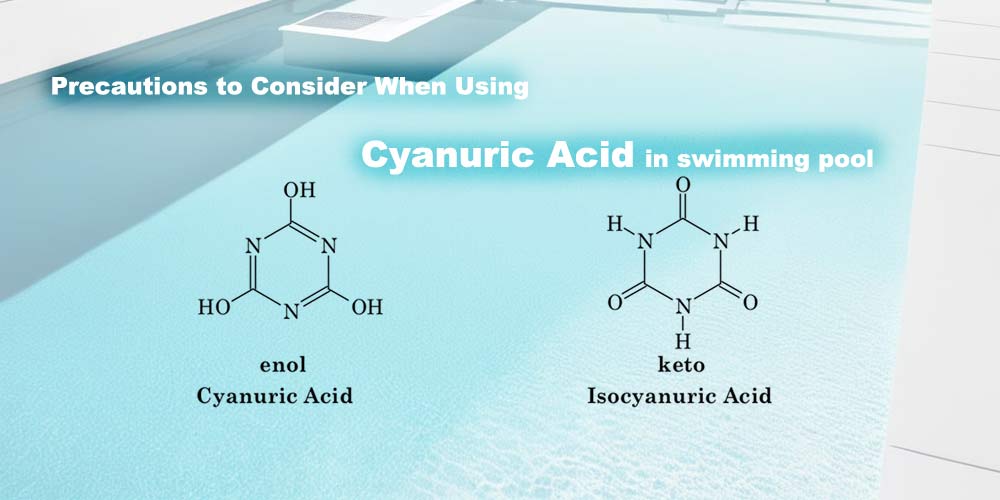Cyanuric acid (CYA) is an essential pool stabilizer that prolongs the effectiveness of chlorine by protecting it from rapid degradation under sunlight. However, while CYA can be highly beneficial in outdoor pools, improper use can lead to unintended consequences for water quality, health, and safety. Here are some key precautions to consider when handling and applying cyanuric acid in swimming pools.
Understanding Ideal Cyanuric Acid Levels
Maintaining appropriate CYA levels is critical. The recommended range for CYA in a swimming pool is typically between 30-50 ppm (parts per million). Levels above 50 ppm can begin to reduce chlorine’s effectiveness, while levels below 30 ppm may leave chlorine vulnerable to UV rays, decreasing its ability to sanitize the pool water efficiently. If CYA levels reach above 100 ppm, this condition is known as “over-stabilization,” where chlorine loses its efficiency, leading to potential algae growth and cloudy water. Therefore, it’s important to test CYA levels regularly, adjusting as needed.
Avoiding Overuse and Frequent Addition
One common mistake is adding cyanuric acid frequently without knowing the current levels. Since CYA is relatively stable, it does not evaporate or break down easily under normal pool conditions. Therefore, CYA levels can only be reduced by water dilution or by using specific water treatment methods. To prevent CYA buildup, limit the addition of stabilized chlorine products like trichloroisocyanuric acid (TCCA) and dichloroisocyanuric acid, which contain CYA. If the pool uses such products regularly, it’s wise to check CYA levels more frequently to avoid excessive buildup.
Testing Regularly for Balanced Water Chemistry
Balancing pool water chemistry is essential when using cyanuric acid, as it affects chlorine’s effectiveness. For instance, when CYA levels are high, the free chlorine concentration needs to be proportionally increased to maintain water sanitation. This relationship is often overlooked, leading to ineffective chlorination even if there appears to be sufficient chlorine. Test kits specifically designed for pools can measure CYA levels accurately, so test water chemistry at least every two weeks during the swimming season and adjust CYA levels as required.
Preventing Health Hazards through Proper Application
When handling cyanuric acid, always wear protective gear, including gloves, goggles, and a mask. Though CYA is generally safe, direct contact or inhalation of its powder form can cause skin irritation and respiratory issues. Additionally, avoid adding CYA directly to pool water when swimmers are present. Instead, dissolve the CYA in a bucket of pool water first, then slowly pour it around the pool perimeter to promote even distribution. This step not only protects users from undissolved particles but also helps the chemical dissolve fully and integrate efficiently into the water.
Managing High CYA Levels Effectively
If CYA levels become excessively high, the most effective solution is to partially drain and refill the pool with fresh water. This method is usually the quickest and most practical way to reduce CYA levels, though it may also dilute other chemicals in the pool. For saltwater pools, the dilution method may be combined with specialized filtration options to remove CYA while maintaining other essential chemicals. Be mindful of local regulations on water drainage, as some areas may restrict pool water disposal to protect the environment.
Ensuring Compatibility with Other Pool Chemicals
Cyanuric acid works best with unstabilized chlorine like liquid chlorine (sodium hypochlorite) or calcium hypochlorite. Stabilized chlorines, such as TCCA and dichlor, already contain CYA and can quickly increase CYA concentration if used too frequently. Combining these chemicals can lead to inconsistent or unpredictable water chemistry, so carefully select and balance chlorine products according to your pool’s unique needs.
Educating Pool Users
Educating pool users about the importance of CYA and its management can lead to safer and more enjoyable swimming experiences. Whether the pool is private or shared in a community setting, understanding basic pool maintenance—including the role of CYA—ensures that everyone benefits from clear, sanitized water. Encourage routine communication about pool testing and any maintenance schedules to foster a proactive approach to pool safety.
While cyanuric acid is an invaluable tool for outdoor pool maintenance, it requires careful handling, consistent testing, and mindful management. By following these precautions, pool operators can optimize CYA’s benefits, ensuring long-lasting, balanced water chemistry that promotes health and safety for all swimmers.
Post time: Nov-06-2024

